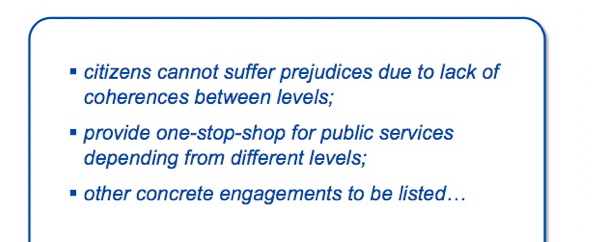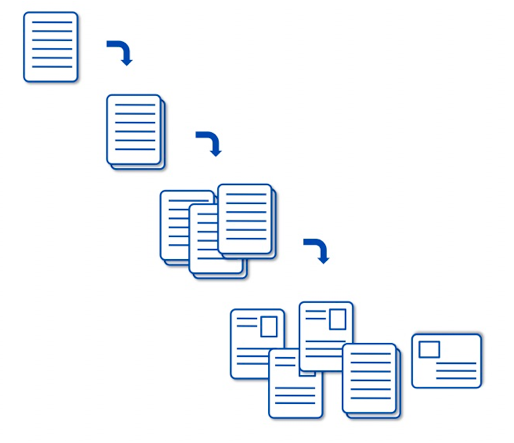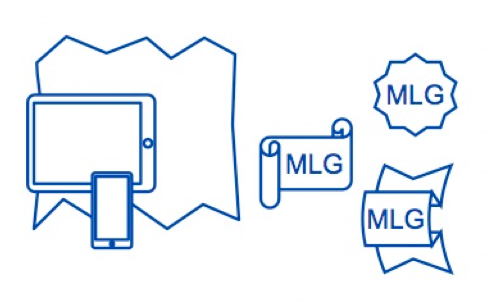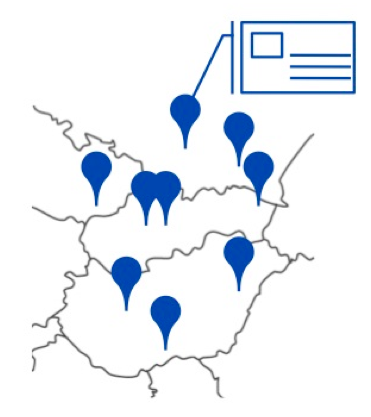Emerging requirements for the MLG Charter
At this stage of the co-design process the various interactions describe above with the different ranges of stakeholders brought 2 types of results:
- The first type of results achieved constitutes the orientations for the design of the Charter both in terms of content and form. These results forms the outline of the future MLG Charter in the form of a series of precise specifications that are presented illustrated with schemes and examples below;
- The second type of results is the convergence of views between the different stakeholders participating: at each main steps of the process so far – the simulation process by the steering Committee; the co-creation workshop; the feedback to the political groups in the occasion of the CIVEX – no particular divergence had to be noticed and participants themselves during the closing sessions mentioned they were sharing similar views.
These 2 types of results have been obtained thanks to the collaborative approach adopted so far: it helps to build at the same time converging and innovative views.
1/ Clear objectives for the MLG Charter…
Objectives and expected benefits of the MLG Charter should be explicit. In the co-creation process, participants tends to see MLG as a solution for any governance problems. The Charter should clarify its objectives and avoid raising too much expectations.
The MLG Charter targets are public authorities at all levels.
The beneficiaries of the use of the Charter and of Multilevel Governance in general are the citizens and civil society.
In particular, this means that the Charter should be accessible and simple enough to be understood by the all citizens. But citizens are not primarily supposed to be able to activate and use directly the Charter.
The Figure below shows some examples of engagement that correspond to the adoption of the MLG Charter from public authorities and presents clearly to citizens the benefits they can expect from the adoption of the MLG Charter.
2/ A multilevel document for the MLG Charter
The Charter should provide different levels of presentation of the principles of multilevel governance from ‘essentials’ expressed in a very simple and accessible way to in-depth discussions of concepts. It is not possible to address all levels with the same text: a multilevel document is requested…
In other words, the MLG Charter should certainly have the form of a hypermedia with different levels of depth as for instance:
- The Charter essentials limited to 20 principles expressed in a simple and accessible way for everyone;
- The second level providing explanations for each principles oriented to the various targets groups (citizens, civil society, economic actors, etc);
- A third level providing case studies of multilevel governance; good and failed practices; ‘how to take action’ practical examples, etc;
- A fourth level with more explanations, background documents, historical evolution of principles addressing experts and scholars.
The different constitutive elements of the MLG Charter should be organized as an hypermedia document with light and accessible parts first and progressively more in-depth and expert-oriented elements.
3 / A multiple entries Charter
The MLG Charter addresses very different type of stakeholders (i.e. elected decision makers, public authorities civil servants, citizens, layers, journalists…). For each of them, the Charter should provide a different entry point according to their interest, level of awareness, expectations, etc.
In particular Public authorities the main entry points emerged from the co-design process are:
- basic principles expressed in a clear way;
- cases and examples form peers presented in concrete and accessible way;
- mapping of MLG progress showing the progressive adoption of the MLG Charter among peer public authorities across Europe and beyond;
- “how to proceed” guideline showing how to take action and start adoption and adhesion to the MLG Charter within a public institution.
For citizens and civil society organizations the entry points are different and the certainly should be:
- concrete presentation of engagements and related examples of directs benefits that could be expected;
- examples of activation of the Multilevel Governance by citizens and CSO leveraging on the Charter;
- didactic presentations accessible for laymen and available to be integrated into education programmes in schools.
For non-public actors, other entry points should certainly be considered:
- sector specific examples of how MLG and the Charter could impact positively specific businesses and activities;
- social, economical, environmental impacts in general and how the MLG Charter could facilitate the transition towards sustainable societies.
Finally for experts, high level education more in-depth entry points should be considered:
- background process of the construction of the Multilevel Governance that leads to the generation of a MLG Charter;
- justifications, evolutions and on-going debate about MLG and the Charter dissemination;
- co-production process of the Charter starting from usage and preliminary versions of the content.
4/ A support to explain multilevel governance
In the co-design process, many situations of application of MLG show one actor at a particular level leveraging on the Charter to induce another actor at another level to take action.
In most of the situations imagined along the co-design process, very often, the second actor is not aware of or familiar with MLG. The Charter should therefore be an help to explain, inform, attract, raise interest on Multilevel Governance.
In the situations depicted in the stories, the 2 actors interacting are not necessarily converging. They may even be in conflict and the role of the MLG Charter should be to facilitate collaboration and the construction of a common understanding of the process. The MLG Charter should therefore provide different and attractive formats: i.e. very short, very simple, self-supporting, illustrated, visual, schemes-based, maps, movie-clips, etc, to suit different situations of interaction and communication between the 2 actors involved.
5/ A label to give visibility to a new governance culture
Many situations imagined by the participants to the co-design process refer to MLG as a new culture of governance based on a set of values. The term will certainly sound not appropriate and exaggerated but beyond the principle and facts a style in the same sense of lifestyle as a modern or advanced way to rethink governance. This new ‘governance-style’ should be reflected in the design of the MLG Charter:
- The form of the charter and the presentation the system of elements that constitutes it should encompass this modernity;
- The impression produced by the Charter and the process that generates it should differentiate from classical public management;
- The forms used for the Charter should make a substantial use of mix-media both paper and digital (Figure );
- Signs of best practices as for instance a MLG label, a European price, forms of reward, etc, should give visibility to this new governance culture;
- The presentation of the Charter and its peripheral elements should be as well unconventional (i.e. ambitious graphics, unconventional supports…)
6/ A map of Europe showing progressive adhesion to the Charter…
The situations imagined by the participants to the Charter co-design refer to a progressive adhesion process to the charter at level of each institution. This adhesion process and a related map as depicted in Figure 14 would allow seeing which actor already adopted the Charter. In general it will also allow following the diffusion of the MLG Charter across regions, countries and Europe in general…
A mapping process of progressive adoption of the MLG Charter should therefore:
- show locally early adopters and followers and allow locally to leverage on the map to induce more dissemination and adoption;
- show globally the progressive diffusion of the Charter and of MLG in general across Europe in order to give evidence of the changes in progress and leverage on it;
- be regularly updated showing a vivid and everyday progression process;
- offer also the possibility to sort adopters by:
- places in order to enable monitoring of engagement of other institutions based in the same geographical area;
- levels in order to enable monitoring of engagement of institutions at the same level in other countries;
- similar institutions in order to enable monitoring of peer institutions engagement.
- offer a service to support diffusion of the charter allowing easy access and monitoring of questions such as: “who adopt already the MLG Charter in my Region?”; “In my sector of activities?”; “Across my peers in Europe?” etc.
7/ A progressive adhesion and transposition process
Participants commented that the adoption process is a long and sometimes difficult process. They suggest proposing a progressive process ranging from adoption of the general principles to setting a programme of local engagements in terms of multilevel governance…. The aim is to generate emulation between stakeholders both in the sense of imitation of peers and competition between actors.
MLG Charter progressive adoption process could present the following stages:
- adoption of general principles of charter as a first steps of declaration of intentions without any binding engagement;
- local diagnosis as a second level of adoption which includes investigating and assessing local governance and providing concrete cases and examples of best practices;
- adaptation and transposition into a local MLG action plan as a third level of adoption proposing a process similar to the Agenda 21;
- setting MLG goals and engagements to be reached within a precise timeframe as a fourth level of adoption. Engagements could be scaled along time setting precise goals each years, assessing progress achieved every year and revising the goals or setting new ones for the coming year (Figure 15). Each yearly assessment is an occasion to organize a local communication on local progresses in terms of multilevel governance.
8/ Reporting obstacles, difficulties in terms of MLG
The situations imagined by the participants proposed to leverage also on progress to be made and local obstacles in terms of multilevel governance. Giving visibility to problems, obstacles and complains from local citizens and institutions is also a good way to create emulation between players and induce them to adopt the MLG Charter in order to align their governance practices.
It is to be noted that such reporting process allows third parties of cases giving voice to cases, problems and difficulties that otherwise would not have the possibility to emerge and gain visibility.
MLG Charter web platform should allow reporting obstacles, difficulties, lacks, etc, in term of multilevel governance. The service could be organized along the following lines:
- obstacles and difficulties reported are checked before being published online in order to filter inappropriate or irrelevant cases;
- actors can find similar cases to the local situation they encounter, compare their difficulties with difficulties form others and check if and how problems have been solved;
- emulation process between institutions to improve their local governance based on the nature and number of difficulties reported;
- possibility to refer to this list to confirm attribution of MLG label to a particular institution
9/ Clarify multilevel governance in terms of benefits
Participants often mention the necessity to introduce multilevel governance into education processes and to clarify what are the effective benefits of MLG both for local concerns of stakeholders and in terms of grand challenges…
MLG Charter system should (re)connect MLG with stakeholders concerns and bridge its potential influence on grand challenges. For instance, answering the following questions could help bringing Multilevel Governance in the forefront and facilitate general recognition of its importance within society:
- why multilevel governance is facilitating life of citizens?
- why is it important for economic actors and competitiveness of Europe?
- how multilevel governance is good for process of sustainability?
- etc.
MLG Charter should be a resource for general citizenship education:
- it should provide educational content for initial education and lifelong learning;
- different quick tutorials, video bullets, TV education programs, etc, could support citizens’ familiarization with the notion of Multilevel Governance.
10/ Charter as entry point for multilevel governance services…
In the situation of use of MLG, participants often refer to services they would like to benefit from to help them taking action and facilitating the adoption of multilevel governance practices.
3 examples are provided below that comes-up first in the stories and feedbacks provided by the participants:
- MLG Ambassadors
The promotion of the MLG Charter at a local level is based on the possibility to train and equip local stakeholders to be MLG Ambassadors in their region, city, etc; - High level training on MLG could be organised by the Committee of the Regions (i.e. “MLG at regional level: example across Europe”; “Mayors meeting mayors on MLG”; etc) to promote Multilevel Governance and the MLG Charter both by training and peer-to-peer interactions;
- Mediators or advisers on Multilevel Governance could proposed by the Committee of the Regions: they could provide the possibility for local stakeholder to get personalised advise, suggestion for taking action; network contact with peers facing same situations and having solved it, etc. Mediators and advisers’ activities could also have a promoting effect for the Multilevel Governance and the MLG Charter.




